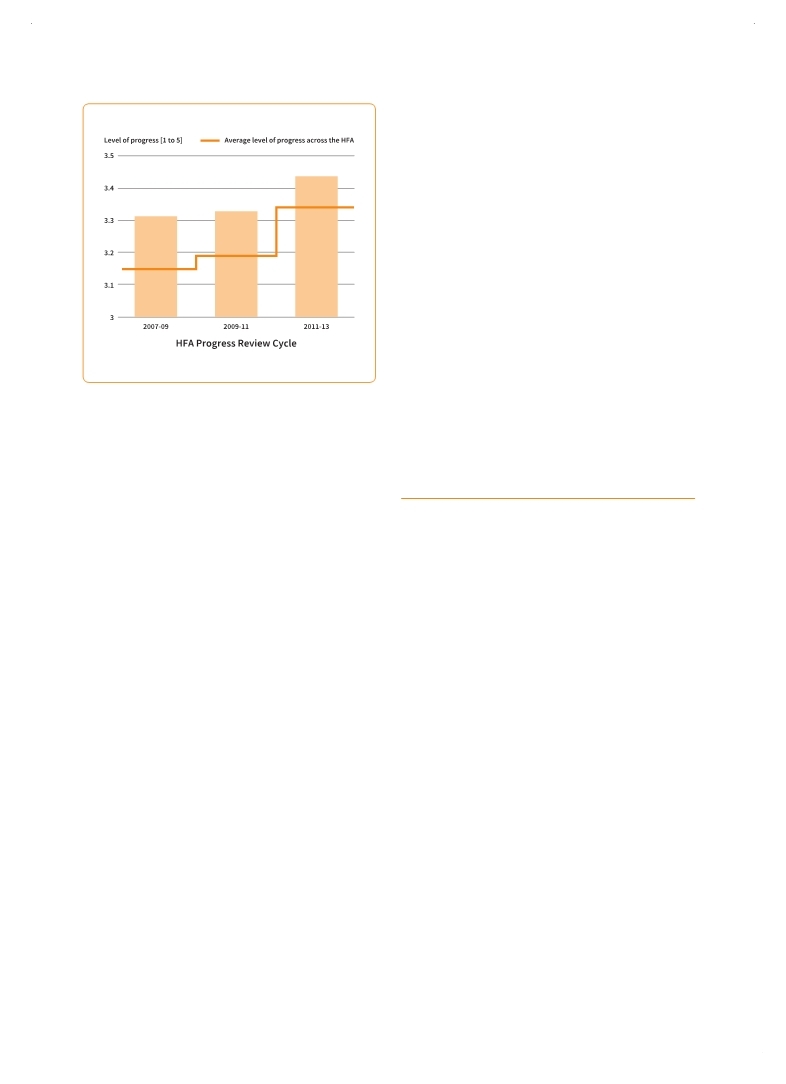 |
Global Assessment Report on Disaster Risk Reduction 2015
Making development sustainable: The future of disaster risk management |
 |
Global Assessment Report on Disaster Risk Reduction 2015
Making development sustainable: The future of disaster risk management |
|
|

120
Part II - Chapter 6
for disaster risk reduction and 85 had created national multi-stakeholder platforms since 2007 (
 UNDP, 2014a UNDP, 2014a UNDP (United Nations Development Programme). 2014a,Disaster Risk Governance During the HFA Implementation Period, Background Paper prepared for the 2015 Global Assessment Report on Disaster Risk Reduction. Geneva, Switzerland: UNISDR.. UNDP (United Nations Development Programme). 2014a,Disaster Risk Governance During the HFA Implementation Period, Background Paper prepared for the 2015 Global Assessment Report on Disaster Risk Reduction. Geneva, Switzerland: UNISDR.. Click here to view this GAR paper. Over the last two years, at least eight countries have established new legal frameworks for disaster risk management. For example, Bhutan (Government of Bhutan, 2013
Government of Bhutan. 2013,Disaster Management Act of Bhutan 2013. . Government of Burkina Faso. 2014,Loi No, 012/2014, Portant Loi d’Orientation relative à la prévention et à la gestion des risques, des crises humanitaires et des catastrophes. Assemblée Nationale.. . Government of Paraguay. 2013,Política Nacional de Gestión y Reducción de Riesgos, Secretaría de Emergencia Nacional y Gobierno Nacional.. . commitment to disaster risk reduction. Although it is still incomplete, the transition from emergency management to disaster risk management which began under the IDNDR has picked up speed and momentum under the HFA (Gall et al., 2014a
Gall, Melanie, Susan Cutter and Khai Nguyen. 2014a,Governance in Disaster Risk Management, 2015 Global Assessment Report on Disaster Risk Reduction. Section on the Future of Disaster Risk Management. Hazards and Vulnerability Research Institute, University of South Carolina, July 2014.. . At the same time, and as highlighted in Chapter 1, the syncretic evolution of the sector from emergency management organizations means that disaster risk management has been principally understood and practised as disaster management. For a number of reasons, this approach has not been effective in achieving the policy goal of disaster risk reduction.
6.2 Prospective disaster risk
management: the divorce between discourse and practice
While a number of new policies, legislation and organizations have been developed and set up, there remains a disconnect between theory, formal arrangements and disaster risk management practice.
In the 1990s, the work of disaster research networks such as LA RED in Latin America, PeriPeri U in sub-Saharan Africa, Duryog Nivaran in South Asia3 (Lavell, 2004
Lavell, Allan. 2004,La red de estudios sociales en prevención de desastres en América Latina, La Red: Antecedentes, formación y contribución al desarrollo de los conceptos, estudios y la práctica en el tema de los riesgos y desastres en América Latina: 1980-2004. . Gellert-de Pinto, Gisela-Irene. 2012,El cambio de paradigma: de la atención de desastres a la gestión del riesgo, Boletín Científico Sapiens Research, Vol. 2, No. 1 (2012): 13-17. ISSN-e: 2215-9312.. . Gall, Melanie, Susan Cutter and Khai Nguyen. 2014a,Governance in Disaster Risk Management, 2015 Global Assessment Report on Disaster Risk Reduction. Section on the Future of Disaster Risk Management. Hazards and Vulnerability Research Institute, University of South Carolina, July 2014.. . Priority for Action 1 of the HFA called for the integration of disaster risk reduction into poverty reduction and other development strategies on the basis of strong political determination by governments. Reflecting these key activities under the HFA, the governance arrangements adopted
(Source: UNISDR with data from the HFA Monitor.)
Figure 6.1 Progress against Priority for Action 1 of the HFA
|
 
Page 1Page 10Page 20Page 30Page 40Page 50Page 60Page 70Page 80Page 90Page 100Page 110Page 111Page 112Page 113Page 114Page 115Page 116Page 117Page 118Page 119Page 120Page 121->Page 122Page 123Page 124Page 125Page 126Page 127Page 128Page 129Page 130Page 131Page 132Page 133Page 134Page 140Page 150Page 160Page 170Page 180Page 190Page 200Page 210Page 220Page 230Page 240Page 250Page 260Page 270Page 280Page 290Page 300Page 310
|
|
 
|
 
|
